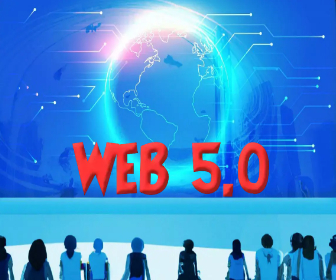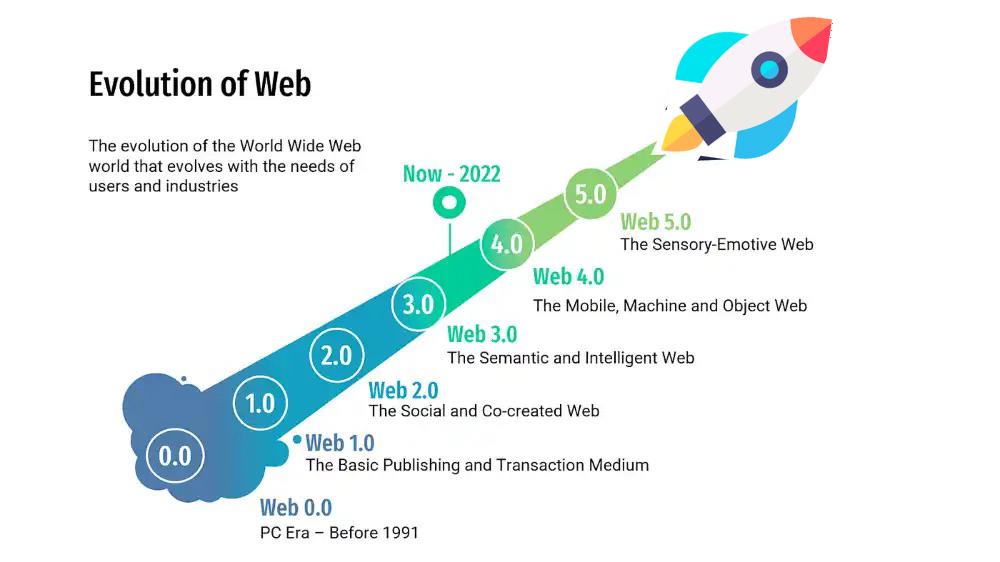From Centralization to Liberation: The Web 5.0 Story
 Ayomide
Ayomide
Introduction
Have you ever wondered who holds the reins of your online presence in this vast digital landscape? As we traverse the intricate pathways of the internet, it becomes increasingly apparent that our digital footprints are not solely ours to control. The strings of our online identity often find themselves in the hands of centralized entities, shaping our digital interactions in ways we might not fully comprehend.
From the static landscapes of Web 1.0 to the intelligent realms of Web 4.0, each phase has brought its unique flavour to the digital experience. However, amidst this evolution, a narrative of centralization has unfolded—a story where a select few dictate the terms of our online existence.
Consider this: as denizens of the digital realm, our data, interactions, and identities often dance in the palms of centralized entities. The once-promised connectivity has, in some aspects, morphed into a complex web of control, raising questions about privacy, autonomy, and the true essence of the internet.
Join me as we embark on this transformative exploration of "From Centralization to Liberation: The Web 5.0 Story."
Navigating the Era of Centralization (Web 1.0 to 4.0) and Decentralization Web 5.0

The evolution of the internet has been marked by a continuous cycle of centralization and decentralization, with each phase shaping the way we interact and engage with the digital world. Let's delve into the distinct phases of the internet's journey, from its static beginnings to the intelligent frontiers of Web 4.0.
Web 1.0: Static Beginnings
The internet's early days, known as Web 1.0, were characterized by static content and one-way communication. Websites served primarily as online brochures, displaying information without much user interaction. Users were passive consumers of content, with limited opportunities for engagement. This era laid the foundation for the internet's infrastructure, establishing protocols and standards that would pave the way for future advancements.
Web 2.0: Rise of Centralized Platforms
Web 2.0 marked a significant shift towards interactive platforms, empowering users to create and share content. Social media platforms, blogs, and wikis emerged, transforming the internet into a dynamic and participatory space. However, this era also witnessed the rise of centralized giants, such as Google, Facebook, and Amazon, who amassed vast amounts of user data and influence.
Web 3.0: Striving for Decentralization
In response to concerns about data privacy and centralized control, Web 3.0 emerged with the promise of a decentralized internet. Blockchain technology, the underlying principle of cryptocurrencies like Bitcoin, offered a decentralized approach to data storage and governance. Web 3.0 aims to create a more equitable and user-centric internet, where users own and control their data.
Web 4.0: Intelligent Web and Intelligent Challenges
Web 4.0, still in its nascent stages, envisions an intelligent web that can understand and anticipate user needs. Artificial intelligence, machine learning, and semantic technologies will play a pivotal role in this era, enabling seamless interactions between users and machines. While Web 4.0 promises enhanced user experiences and personalized services, it also raises concerns about data privacy, algorithmic bias, and the potential for AI to exacerbate existing societal inequities.
Web 5.0: The Decentralized Revolution
Web 5.0 represents the next evolutionary step of the internet, aiming to address the limitations of its predecessors and usher in a more decentralized, user-centric, and intelligent web experience.
Key Characteristics of Web 5.0:
Decentralized Identity and Data Storage: Web 5.0 envisions a shift away from centralized data storage and identity management. Users will have greater control over their personal information, potentially using blockchain or other decentralized technologies to store and manage their data.
AI-Powered Applications and Services: AI will play a central role in Web 5.0, enabling intelligent interactions between users and applications. AI will be used to personalize content, provide real-time recommendations, and automate tasks, enhancing the overall user experience.
Semantic Understanding and Context Awareness: Web 5.0 applications will be able to understand the meaning and context of user interactions, enabling more natural and intuitive communication. This will be achieved through advancements in natural language processing (NLP) and machine learning.
User-Centric Design and Governance: Web 5.0 will prioritize user control and empowerment, giving individuals more say in shaping the internet's future. This could involve decentralized governance models, where users can participate in decisions regarding platform rules and data usage policies.
Potential Benefits of Web 5.0:
Enhanced User Privacy and Data Ownership: Users will have greater control over their personal information, reducing the risk of data breaches and misuse.
More Personalized and Relevant Experiences: AI-powered applications will tailor content and services to individual preferences and needs.
Seamless and Natural Interactions: AI and semantic understanding will enable more intuitive and natural communication between users and applications.
Empowered Users and Decentralized Governance: Users will have a greater voice in shaping the internet's future, promoting a more equitable and democratic online environment.
Unveiling the Key Differences from 1.0 to 5.0
| Feature | Web 1.0 | Web 2.0 | Web 3.0 | Web 4.0 | Web 5.0 |
| Content | Static, read-only | Interactive, user-generated | Decentralised, semantic | Intelligent, adaptive | Immersive, experiential |
| Data | Centralized, controlled by platforms | User-centric, decentralized | User-owned, blockchain-based | Ubiquitous, interconnected | Personalized, context-aware |
| User Engagement | Passive consumption | Active participation, collaboration | Ownership, control | Personalized interactions, anticipation | Seamless interactions, empathy |
| Platforms | Limited, centralized | Diverse, centralized and decentralized | Decentralized applications | Intelligent platforms, ambient computing | Immersive platforms, augmented reality |
| Technology | HTML, HTTP | Web 2.0 APIs, JavaScript | Blockchain, Semantic Web | AI, machine learning, IoT | AI, semantic understanding, natural language processing |
| Challenges | Limited interactivity, lack of user control | Data privacy concerns, centralized control | Scalability, security, interoperability | Algorithmic bias, fairness, privacy | Technical complexity, security, scalability |
| Potential Benefits | Increased information access, global connectivity | Social interaction, collaboration, innovation | User empowerment, data ownership, privacy | Personalized experiences, seamless interactions | Immersive experiences, empathy, understanding |
Challenges and Considerations for Web 5.0
Technical Complexity: Developing and implementing Web 5.0 technologies will require significant advancements in AI, blockchain, and other emerging technologies.
Scalability and Interoperability: Ensuring that Web 5.0 applications and services can scale effectively and operate seamlessly across different platforms will be crucial.
Security and Privacy Protections: Robust security measures will be essential to protect user data and privacy in a decentralized environment.
Addressing Algorithmic Bias and Fairness: Ensuring that AI algorithms are unbiased and fair in their decision-making will be critical to avoid perpetuating existing societal inequities.
Web 5.0 is still in its early stages of development, and its full potential remains to be realized. However, the concept holds promise for a more secure, user-centric, and intelligent internet that empowers individuals and addresses the challenges of current web paradigms. As the internet continues to evolve, it is essential to carefully consider the implications of these emerging technologies and ensure that Web 5.0 fulfils its promise of a more equitable and beneficial digital future.
Conclusion
The internet, a once static and centralized platform, has embarked on a remarkable journey towards decentralization and liberation. Web 5.0 represents the culmination of this evolution, promising a future where users take ownership of their data, interact seamlessly with AI-powered applications, and collectively shape the digital landscape.
Call to Action
As we stand at the threshold of this transformative era, it is our collective responsibility to embrace and actively participate in the Web 5.0 revolution. Let us seize the opportunity to reclaim control over our digital lives, foster innovation, and build a more equitable and inclusive online environment.
Final Thoughts
The future of the internet is not merely an evolution; it is a liberation. Web 5.0 beckons us to step beyond the limitations of centralized control and embrace a decentralized paradigm where data, applications, and governance are in the hands of the users. Let us collectively shape the next chapter of the internet, one where we are not mere spectators but empowered participants in shaping a digital world that serves our collective needs and aspirations.
The journey towards a decentralized and user-centric web is not without its challenges. However, the promise of enhanced user control, enhanced security, and personalized interactions fuels our collective determination to overcome these obstacles. Together, we can usher in a new era of the internet where data liberation, innovation, and collective governance reign supreme.
Embrace the Web 5.0 revolution, become a part of its shaping, and witness the transformation of the internet into a truly empowering and inclusive digital realm.
Subscribe to my newsletter
Read articles from Ayomide directly inside your inbox. Subscribe to the newsletter, and don't miss out.
Written by
